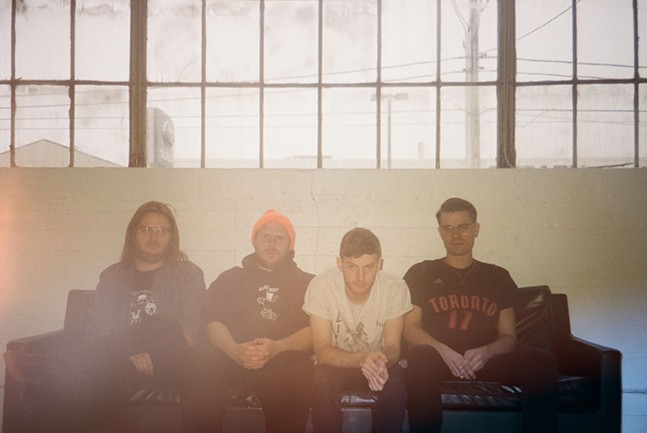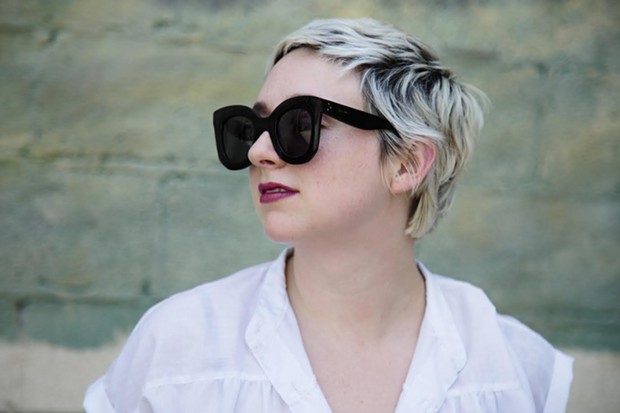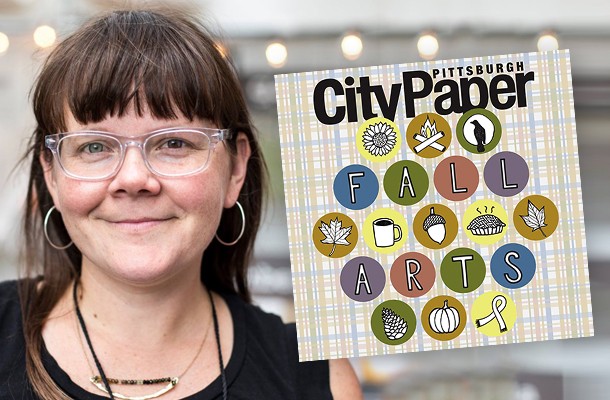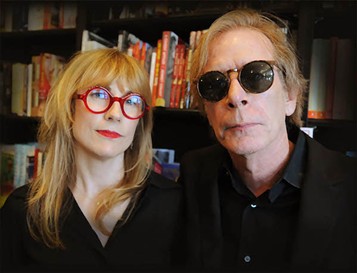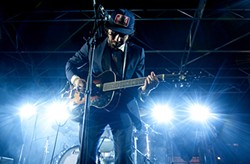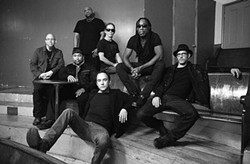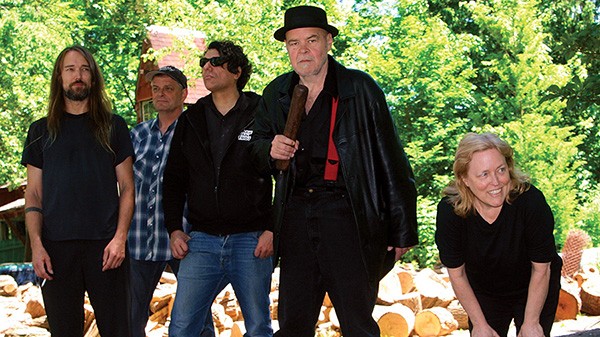Tuesday, November 1, 2016
Toronto’s PUP is a scrappy punk band; it creates raw music deeply rooted in honest lyricism and technical riffs. It’s dark, but it’s also fun, and the band’s manic energy is best captured in live performances. Shows are marked by sweaty dancing, stage-diving and passionate singalongs. City Paper called PUP frontman Stefan Babcock on the band's day off in NYC and chatted about touring, maintaining relationships, and who’s the best driver in the band. Sunday, PUP comes to Pittsburgh for a sold-out show with Cayetana and Chastity at Cattivo.
Last time we spoke, a few months ago, you insisted that PUP was going to take it easy. When did you decide you just weren’t going to do that?
We’re on tour for 100 days right now, so three-and-a-half months. This is probably the longest tour we’ve ever done, with only three days off. I swear that next year, next album, we’ll take it way easier.
But it’s hard to say no when good things happen, as much as I’d like to go home at this point and sleep in my own bed. Things are going really good for us right now, and we really appreciate this opportunity.
It feels pretty amazing that we can tour the world and sell out small shows. Are people still going to be excited about us in two years? Two months? I don’t know, so if we got an offer to go to Australia and headline cool shows and play some festivals, we’re not gonna say no. We might as well take advantage of it now.
After your second time in Australia, what are your thoughts on traveling there?
Australia’s the only place with pop-punk commercial radio. We sold out every show, it was all awesome, and it’s such a surreal feeling to be that far away, on the other side of the planet and have people yelling out these weird geographical Canadian locations.
We didn’t get to hold any koalas on this trip, but we did the first time. My girlfriend was angry and jealous because she loves koalas, so I bought her a little koala stuffed animal, but she hates it because it reminds her that I got to hold a real koala [laughs].
Do you ever feel people know too much about you from your personal lyricism?
The first record was pretty personal but less so than The Dream is Over. It didn’t really occur to me as I was writing, I just remember the day that it came out we were playing a show in Montreal and one of my oldest, closest friends who I have a very deep connection with was like, “This is fucked. People are gonna know a lot about you and assume a lot about you.”
I don’t regret writing those lyrics, but it was a weird thing I didn’t think about until it was too late. It’s OK, though, I think that’s just what happens. I think also people get the wrong impression of me. A lot of people coming up to me at shows and are like, “I’ve got a bag of drugs for you in the back,” and I’m like “no!” I guess since I talk about being a piece of shit a lot? [laughs]
I think the sentiment is nice. They want all of us to have a good time. But they really read something between the lines that is not correct [laughs].
The first time I heard “Sleep In the Heat,” I thought it was about a person, but when I saw you perform last you said it was about your pet chameleon who passed, Norman. Somehow that was even more sad to me than the loss of a human being. Is it hard to play such a sorrowful song live?
[Laughs] My girlfriend, Amanda, was in the studio while we recorded this song, and she was like, “There’s one love song on this record, and it’s about a fucking chameleon.”
There’s a certain emotional distance when you are in a show environment and everyone’s going off, so some of the lyrics sort of lose a little meaning to me, but every time we play it I miss Norman. It seems like people are having fun at our shows, so it feels more like a celebration of his life, not a bummer song. I love playing that song live.
Every single one of you has a girlfriend, so how do you manage your relationships while away?
It’s really hard. Dating us is really hard, dating anyone in PUP is hard. Dating anyone who tours is hard. We date really cool understanding girls who are supportive, so you figure out how to make it work. You have to figure out what works best for you, be it texting a lot, or whatever. You figure out how to keep the spark alive when you’re never home. And we get nice days like today, where all our girlfriends flew in for the show last night and we all get to hang out separate for the day. My girlfriend, [photographer] Amanda [Fotes], is coming for three days to shoot and then it’ll be back to boys world [laughs].
You had a vocal-chord injury — since then, how do you treat touring differently?
What happened was my vocal chords hemorrhaged, I couldn’t make a sound for over two weeks. My doctor was like, your two options are surgery or vocal therapy. We’re road dogs, so surgery was not gonna work for us. With vocal therapy, there’s a physical-therapy component, so it’s almost like a throat massage, they realign the muscles around your vocal chords. I was on vocal rest for almost a month. For two weeks I didn’t make a sound at all, for two weeks I whispered, and then I had five months of rest.
Now I warm up for half an hour everyday, I don’t drink as much, and I always do 15 minutes of warm-down. I don’t smoke weed on tour anymore, and there’s a dietary component. Most people don’t really think about the abuse that you put on your vocal chords when you scream. Like any muscle you have to rest it.
Who is the best driver?
The best driver is Nestor, definitely. He’s the band dad. I’m the band mom, I worry about stuff and make all the arrangements and plans (this is based on my own parental experience), and as band dad he fixes all the broken things, he’s calm under heavy pressure, drives us around, takes care of the van, and is pretty much the cool head when we need it.
If your band was a food, what kind of food would it be and why?
Have you ever had soup dumplings? We just had them for the first time in NYC. There is meat and soup inside the dumpling, and they were delicious and spicy, and I feel like PUP’s a little bit like those soup dumplings. We’re like this contained ball of spicy, if anything goes wrong it bursts hot, spicy, stuff all over. [Laughs.] Like a metaphor how we’re always on the verge of a total breakdown. We’re always riding that rail, and that’s what eating soup dumplings is like. Like if you pick it up with chopsticks wrong it bursts and explodes all over the place.
If this tour doesn’t kill you…
We’ll come back to New York and have more soup dumplings.
PUP, CAYETANA, CHASTITY 7 p.m. Fri., Nov. 4. Cattivo, 146 44th St., Lawrenceville. Sold out. 412-687-2157 or www.cattivopgh.com
Thursday, October 6, 2016
The muscle behind Switchfoot’s newest album, Where The Light Shines Through, is the one-two punch of spotlighting the dark and offering hope for what they find there. It’s summed up in the anthem of the title track: “the wound is where the light shines through.”
During the band's fall tour, which brings the members to Stage AE on Oct. 12, they’re not only singing about giving people hope, they’re actually giving people hope. They’ve partnered with Cure International, an organization that seeks to heal children with treatable disabilities from 29 countries.
“We got to experience one of those hospitals while we were in the Philippines earlier this year,” drummer Chad Butler explains over the phone. “It's an incredible organization, so [we would] definitely like to highlight them on this tour.”
Jon Foreman talked in an interview about how you all had to fight for the songs you wanted on this record. Were there any songs you personally had to fight for?
For the most part ... we agree on the majority of it, but usually the last one or two songs that you're deciding to cut ... that's when the arm wrestling starts [laughs]. The intensity goes up a notch. Because, I think, as an individual, you become attached to a song, whether it's a particular lyric or just the way it makes you feel, and they mean different things to different people. So in particular, there was a song — "Bull In A China Shop" — that I really wanted to be on the record, and I remember that one being a point of contention for sure. Maybe it's because I'm a drummer, and thinking about the live show, that one seemed like one that I wanted to play every night. So I fought for that one for sure.
How do you guys work that out? How do you come to a decision?
... Ultimately, the passion is what wins. So if somebody has really got a strong opinion, they just have to formulate their case, you know. In the studio, you have to really fight for the song. But ultimately, those arguments are to better the art. You don't take it personally — you have to have thick skin to take the passion for the song but not be looking at it beyond that as far as someone's character. It's more about if you love the song, you're going to fight for it tooth and nail.
This album is very different but still classic Switchfoot at the same time. Did you guys approach this album differently than you did others?
With Fading West, we started without guitars intentionally to try to take the music somewhere new. But [for] this record, we started with guitars. It's a rock guitar record from the very get-go. For me, it's kind of a return to the guitar rock songs that Switchfoot's known for.
Do you guys ever think about or talk about how Switchfoot's music could affect people and stick with them?
Yeah, absolutely ... The goal of this band has always been to communicate hope. And the goal of this record, the reason why we made this record is because hope deserves an anthem. And for us, wrestling with big questions of life and looking for hope in the dark places. It's really what motivates us and keeps us going as a band. It's more than just about rock n' roll — this is about a desire to communicate hope and to explore the world through songs. And I think that's the beauty of art, is that you can really talk about things that are deeper, that are maybe uncomfortable or off-limits for everyday conversation. But through the songs you can explore those things in a meaningful way.
SWITCHFOOT with RELIANT K. 6 p.m. Wed., Oct. 12. Stage AE. 400 North Shore Drive, North Side. $32.50-35. 412-229-5483 or www.stageae.com
Tags: Switchfoot , Chad Butler , Stage AE , Reliant K , FFW>> , Image
Friday, September 30, 2016
Allison Crutchfield is stepping back into the spotlight. As a co-founding member of Swearin’ and P.S. Elliot, she’s spent much of her life making music alongside friends and her sister Katie Crutchfield, of Waxahatchee. In 2014, she released Lean Into It, a seven-track EP that marked the beginning of her solo project. This year she returned to that project, signing with Merge Records, which will release her debut full-length next year. In the meantime, fans can get a sneak peek at that record as Crutchfield hits the road with her backing band, The Fizz. The tour will carry her through much of the United States, including an Oct. 2 stop at Cattivo. Ahead of the Pittsburgh stop, Crutchfield talked to CP by phone about the Merge signing, recording the new album and making time for music.
It was announced that you signed with Merge this year. That must be really exciting. How does it feel to be a part of that label? And was that something you ever imagined when starting out?
I mean, it feels incredible. At the risk of sounding so trite and cheesy, signing with a label like Merge was a literal, like, stare-out-the-window-during-geometry-class daydream fantasy for me, always, and the fact that it’s happening and that, bonus, they’re the greatest people, is just really wonderful. I feel really lucky and grateful.
What was the recording process like for the forthcoming album? What kind of material can fans expect and how might it differ from your EP?
The album is already finished and the recording process was kind of an amazing breeze. I feel like I’m generally an over-preparer when it comes to recording, and so to be working with someone new — the very talented [engineer/producer] Jeff Zeigler — and making my first solo album, it was pretty much ready when we walked into the studio. That left us with lots of time to add overdubs and harmonies, and to just really hone in and focus on what we were doing. I feel like the album is thematically an extension of the EP, but sonically is much more expansive.
Did any of the previous work you did with Swearin' or P.S. Eliot influence this recording?
Sort of. Every other band I’ve been in has revolved in some way around a very close relationship, and that dynamic has been the main creative driving force. So this project kind of finds me without that; I’m motivated by something different, and finding the motivation is a new experience for me.
You're touring with your band, The Fizz. Who are some of the members and how does the band help to bring your songs to life for a live audience? Will you be performing any new songs live?
Right now we’re kind of a power trio, which I’m super into. I play synth and guitar, Sam Cook-Parrott plays bass and Catherine Elicson plays drums. I really love being in a rock band, and I think we play these sad synthy pop songs like a rock band. We’re definitely playing a chunk of the new songs on this tour.
You're also part of your sister's live band for Waxahatchee, so it would seem like you’re often on the road. Do you enjoy touring and how do you balance life on the road with creating new material?
I have my moments where I really love being on the road, and I’m so thankful that I get to travel so much and play music, but I’m also such a creature of habit, so sometimes being on tour can be a challenge for me. I do enjoy it a lot of the time, though. I feel like I find balance by allowing myself to take breaks; putting pressure on myself to write is the absolute worst thing I can do to actually make songs I care about. Usually by the time I’m feeling like writing again, I’m so ready and it’s all easily accessible in my brain.
ALLISON CRUTCHFIELD & THE FIZZ, SPACE BUNS FOREVER, RUE 7 p.m. Sun., Oct. 2. Cattivo, 146 44th St., Lawrenceville. $10-12. 412-687-2157 or www.druskyentertainment.com
Tags: Allison Crutchfield , Cattivo , Swearin' , P.S. Elliot , FFW>> , Image
Wednesday, September 14, 2016
Amy Garbark is the solo force behind garbella, a popular local shop of goods and gear that she draws, designs and screenprints herself. Her “I [bike] PGH” and “P is for pierogi” shirts have been on Pittsburgh gift lists for years: She was crowned “Best Pittsburgh Crafter” in City Paper’s 2012 Best of Pittsburgh Issue and we featured her “Dear Pittsburgh, I love you” T-shirts as one of our personal must-haves in our Stuff We Like [] column in 2015.
Amy grew up in Pittsburgh and lives in Lawrenceville’s 6th Ward with her husband, Steevo, and their newly adopted dog, Cinder. In addition to working in her shop and exhibiting her designs at retail shows across the United States, she also plays drums and sings for local band Reign Check and has mentored young artists at Girls Rock! Pittsburgh, a local rock camp empowering girls through music. We caught up with her over email after she was finished with this week’s Fall Arts cover illustrations to get her thoughts on Pittsburgh’s art scene and owning her own business.
You seem to travel a lot for work. What's your favorite thing about Pittsburgh’s art scene that tops other cities you’ve been to?
I love the sense of community and camaraderie among artists, makers and designers in Pittsburgh. I have had lots of people in other cities tell me that they are envious of our Pittsburgh scene because there seems to be more collaboration than competition.
When did you figure out you wanted to be an artist?
Hmmmm … I can’t pinpoint one specific moment that I decided to be an artist. I have always liked making art, as far back as I can remember. I had fantastic art teachers in high school who encouraged me to pursue it. I went to school for art at Alfred University, but it was a bit of a journey to get where I am today. Shoe store, office job, back to school to get art-teacher certification, arts-based youth programming nonprofit, to quitting my full-time job six years ago to pursue garbella full time.
What’s it like being your own boss?
It’s the best! It’s great to be able to determine the structure of your day and environment of your workspace. However, with this awesomeness, also come some challenges. That being said, I’ll take the challenges of being my own boss over any other option.
What’s your biggest selling item in your shop?
Hands down: the “P is for pierogi” baby one-piece.
What’s your personal favorite?
The Always Be Snackin’ design is probably my favorite because it’s pretty much been my motto since I was a tiny kid.
You introduce new designs pretty frequently. Is it hard coming up with new ideas?
Sometimes! I prefer to just create and release new designs when I have an idea and feel like putting it out there. However, when I feel pressure to release a new collection, then it can sometimes be a little challenging for me.
I saw you recently were one of the featured sellers in Etsy’s Open Call event where you got to pitch your products to big-name buyers like Macy’s and Whole Foods. That’s so cool! Was it super intimidating?
Thanks! Yeah, I’m really grateful and honored to have been chosen as a finalist and really appreciate the opportunity. At first, the thought of pitching to the huge retailers felt a bit overwhelming and intimidating. However, when you really get down to it, they’re human and relatable, and I know my business and products better than anyone, so who better to pitch to them, right?

Where can folks buy your merchandise in Pittsburgh?
Wildcard, Brambler Boutique, The Picket Fence, Robin’s Nest, West Elm, and So Me in Glenshaw. Also, you can order from my online shop [http://garbelladesign.com/shop] and pick up at my studio, or come to one of our studio open-house sales, or at various craft shows and markets each year, like Handmade Arcade, I Made It! For the Holidays and Three Rivers Arts Festival.
In addition to art, you’re involved in the local music scene too, from drumming in a local band to mentoring young female artists in the Girls Rock band camp. What kind of music do you listen to when you work?
I listen to lots of different music and podcasts and sometimes audiobooks too. For music, I am always listening to a variety of genres and like to check out some new stuff, but ’90s indie rock still gets played in pretty heavy rotation.
I love the support and courage that Girls Rock provides young girls looking for female role models.
I agree. The Girls Rock PIttsburgh! Camp is one of my favorite times of the year! It’s completely volunteer run by an incredible group of women with diverse talents and skill sets, and the campers are incredible.
Did you have any female artists or musicians you looked up to when you were a kid?
Yes! The first album I remember really, really connecting with was Sinead O’Connor’s I Do Not Want What I Haven’t Got, which came out on my 11th birthday. I have two older siblings, so they both also introduced me to a lot of new music from there. My brother played in bands and went to a lot of shows and let me start tagging along to shows when I was 12 and 13. Seeing women play in bands like Jawbox, Superchunk, Velocity Girl and Tsunami had a lasting effect on me and was an important part of my formative early-teenage years.
Your cover illustrations this week include lots of cute fall icons. What’s your favorite season?
Is it a cop-out to say I love all of the seasons? I really do! I love the variety of four seasons: the long days of summer, the cooler crunchy-leaf days of fall, the hopefulness of spring and the crisp air of winter with a side of cozy. However, if I have to rank them, then: summer, fall, spring and winter.
Do you have any projects coming up people should look out for?
I’ll be participating in the Lawrenceville Artist Studio Tour on Nov. 19, so stop by if you want to check out my workspace and pull a print!
Wednesday, September 7, 2016
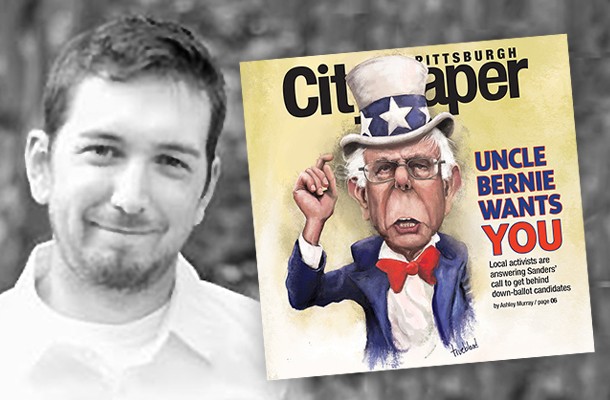
Pittsburgh-based artist Jonathan Trueblood first reached out to me through City Paper’s Instagram account in March, letting me know he’d love to illustrate a future cover. After I saw his great caricatures of famous faces like David Bowie and Mario Lemieux on his account, I knew I wanted to keep him in mind the next time I needed a portrait.
After finding out this week’s cover story was going to be on Bernie Sanders’ supporters uniting behind down-ballot candidates, I pitched the idea of Bernie Sanders as Uncle Sam, portraying him as this year’s new face of American politics. Editor Charlie Deitch signed off on the idea, and Jonathan came on board as soon as I emailed him.
Originally from Baldwin, Jonathan is a graduate of Edinboro University and has his master’s degree from Carnegie Mellon University. In addition to illustrating, he’s also a graphic designer, animator and an assistant professor at Point Park University, teaching classes like Storyboarding and Fundamentals of Motion Graphics and Visual Effects. He also used to work in New York City making commercials.
We caught up with Jonathan over email after he was finished with this week’s illustration and got his thoughts on Pittsburgh’s art scene, cartoons and the best advice he gives his students.
What’s your favorite thing about being an artist in Pittsburgh?
I think the artist scene in Pittsburgh is a very tightly knit group. Everyone knows everyone, and they definitely look to encourage work and exposure for each other. I think the more the art scene in Pittsburgh grows, like it seems to be, it will be great for all. A rising tide lifts all boats!
What’s your work space look like?
Haha! My work space is my living-room couch. I have my laptop and my Wacom Cintiq each on a TV tray, and Netflix playing in the background. I have a room that is supposed to be my “office/workspace,” but I’ve been too busy or lazy to get it cleaned up and ready.
Tell me about your process behind this week’s cover illustration of Bernie Sanders.
I always start by finding the best reference photo or photos of the subject. It’s weird to say, but not every picture looks like the person you are trying to draw, or the picture doesn’t capture their personality. Once I grab several photos, I do some quick sketches to get an idea of how I want to exaggerate the features. Some people are much easier than others. Once the sketch is done, I start “painting” in Photoshop. Then it’s a lot of trial and error moving features around, painting and re-painting, and praying that it will look right when it’s all done. I also always send my work to a couple of my friends from college who always give me good advice and criticism. I know they’ll always be honest with me and really tell me if I need to fix the image to make it look more like the person.
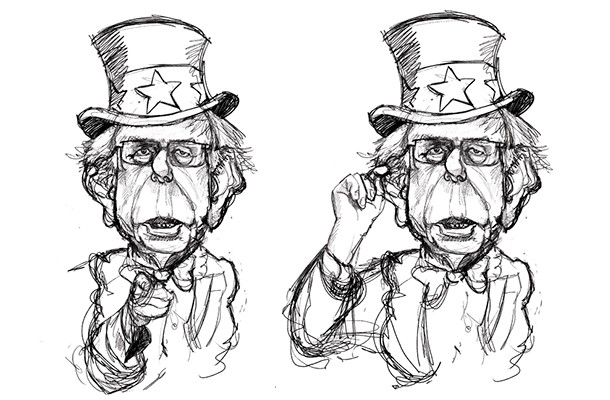
In addition to illustrating, you also teach animation at Point Park. That basically means you get paid to make cartoons all day, right?
I joke about that all that time … that I get paid to make cartoons. It’s true, though. I’m very lucky to do something I love. When I’m not teaching animation, I’m also making animations for various clients, drawing storyboards, illustrating and doing graphic design.
Speaking of cartoons, do you have a favorite?
My favorite animated movie is The Lion King. If I had to pick another cartoon, I would say “Rejected,” by Don Hertzfeldt.
What’s the best advice you give your students who are just starting to figure out what they want to be when they grow up?
I have a friend that used to work out all the time at the gym. He used to wear a shirt that said, “Everyday you don't lift, somebody else does.” I think that applies to working at getting into the field of animation. It’s a very competitive industry. I tell my students that every day you aren’t working on your portfolio, animating, drawing, learning or getting better, somebody else is, and they are the ones that will get the job at the studio you want. Work hard and love what you do, and you’ll be fine.
Your celebrity caricatures are spot on. Is there one in particular who’s the most fun to draw?
Wow! There are so many! I’ll say this ... the funnier-looking the person is, the more fun it is to draw them. It’s also easier too.
I discovered your work after you contacted me through City Paper’s Instagram account. Do you think social media is changing the art world in any way?
Absolutely! Social media sites like Facebook, Instagram and Dribbble have been fantastic avenues for me to reach out to new people to work for and collaborate with. I think the trick for any artist is to be unique. Develop your own personal style.
You mentioned that you used to work in New York City making commercials. Have you done anything we’d recognize?
I’ve been back from NYC since 2006, so it’s been a long time since I’ve done anything on TV. If you used to watch TV shows like Viva La Bam, Jackass, The Tom Green Show, Pimp My Ride and any of those MTV shows, you would have seen some of my projects. My favorite one I ever did was to promote a new band every other week. We would do eight 10-second long animations for each band. Like mini music videos. They would play in and out from commercial breaks. I think in a year we did about 100 or so of those little animations.
Where can we follow your work?
www.blackpowderdesign.com, www.bitteryinzer.com, and on Instagram, it’s @blackpowderdesign.
What question do you wish I had asked you?
I wish you would have asked me about my family. I’m married to my best friend and beautiful wife, April. We have two ridiculously cute and amazing little boys, Cash (3) and Tig (1). I’m a very, very lucky guy!
Tags: Bernie Sanders , City Paper , Pittsburgh , Cover , Instagram , Graphic Design , Illustrations , Image
Monday, August 8, 2016
Count among them Jeffrey Toobin, staff writer at the New Yorker and legal analyst for CNN. His new book Heiress: The Wild Saga of the Kidnapping, Crimes and Trial of Patty Hearst (Doubleday) chronicles the kidnapping in the context of a very troubled decade in a very troubled state.
Toobin will discuss the book and its story tonight at Carnegie Library Lecture Hall. CP called him to discuss the book a few hours prior.
You were a teenager when the story of Patty Hearst’s kidnapping broke. Do you remember your response to the story at the time?
To be honest, I have very little first-hand memory. I was aware of it in the way that a 13-year-old is aware of big issues in the news. I was kind of a Watergate junkie as a kid, so I knew more about Watergate than I did about the Hearst case.
There was this weird thing where it came out that one of the places she was held briefly, or one of the places she stayed briefly, was on my block in Manhattan on West 90th Street, and I remember joking with my parents about that — “Did you see her?”
That’s funny, I was just talking to a coworker who grew up in San Francisco and had hoped as a kid to be the one to find Hearst.
Speaking of that time period, the immediate aftermath of her kidnapping I feel gets lost in the madness and oddity of the whole story. We don’t hear much about the very beginning of the story. Can you talk about those first few weeks after her kidnapping?
Well, I think it’s important to say that this was a horrible and terrible experience, to be kidnapped. I don’t think we should minimize the horror of what she went through. To be thrown in a car trunk by people she knew to be murderers, who had killed Marcus Foster, the Oakland school superintendent, and bragged about it, was terrifying. But in the bizarre way of how this story unfolded, things changed over time.
When did you become interested in writing about this story?
It was really only a couple of years ago. I had not really thought about it. But then I wrote a story for the New Yorker about a gang that took over a jail in Baltimore. I got interested in the history of the gang, which is called the Black Guerrilla Family. It was founded by George Jackson, the famous prisoner in Soledad prison. I discovered that the prisons in the ‘70s, especially in California, were sort of hotbeds of political activity, and it turned out that the Symbionese Liberation Army came out of the same world. And that’s what lead me back to the Patty Hearst story, through the New Yorker story I wrote.
You’ve also written in depth about the O.J Simpson case with The Run Of His Life: The People v. O.J. Simpson (which was adapted for television on FX). Both stories feel emblematic of their decade. Hearst’s in the context of Watergate, Vietnam, domestic terrorism, classism in the 1970s and Simpson’s in celebrity, television, race, and voyeurism in the '90s. Did you run into other parallels between the two stories?
What was particularly striking to me was just how violent and dangerous things were in the '70s. The unbelievable amount of crime, political crime, a thousand bombings a year — just think about that idea of a thousand political bombings a year — which was going on in the '70s. The nature of criminal spectacle certainly was a parallel between Patty Hearst and O.J. But the magnitude of public attention was certainly greater in the '90s because there were just so many media outlets at the time.
What would you say is the biggest misconception about Patty Hearst in the general public?
Well, that Patty Hearst was coerced to commit one bank robbery, when in fact she committed an extraordinary number of crimes over the course of nearly a year and half. Three bank robberies, including one where a woman died, shooting up a street in Los Angeles, setting off bombs in Northern California. This was not a single act she was coerced to commit — this was a crime wave she was an intimate part of.
I imagine it’s because of that iconic photograph of her at the bank.
The photo obviously is the defining image of the experience, but also I think she did a pretty good job of convincing people that this was sort of a one-off thing.
Why do you think this story resonates so well with the general public?
Because it’s a mystery. I think people identify with the mystery. The question of whether a kidnap victim can turn into a fellow criminal with her kidnappers is a very compelling question and I think people remain fascinated by it, and often react very differently.
My purpose in telling the story is not so much to advocate for one view of her or another, but to lay out the full story in all its strangeness and that, to me, is more interesting than the psychobabble you often hear about the case, about brainwashing, about Stockholm syndrome, terms that are more journalistic than medical.
What’s life for Patty Hearst been like since this story took place?
Perhaps the most bizarre and interesting thing of all about Patty Hearst’s life after the kidnapping is that she has led the life for which she was destined. She is a homemaker, a socialite, a rich woman in the suburbs, and a mother, a grandmother, with a few quirky interests like being in John Waters movies a couple times. But basically she has led the life for which she was destined, notwithstanding this extremely bizarre interlude.
Tags: Jeffrey Toobin , Patty Hearst , Image
Wednesday, July 13, 2016
As the authors mark its 20th anniversary, with an edition that includes a new afterword, they will visit Pittsburgh for a reading at the Ace Hotel on Monday, July 18. City Paper spoke to McCain, before a reading in London two weeks ago.
How did the book come to life?
Legs [McNeil, co-author] had been doing a book with Dee Dee Ramone and had suggested to Dee Dee that they do it as an oral history because Legs was such a fan of the book Edie by Jean Stein and George Plimpton. So they started it. But Legs was also interviewing [music publicist/journalist/Ramones manager] Danny Fields and Richard Hell and kind of cut it together with Dee Dee. And Dee Dee was getting a little hard to work with. I was reading all these transcripts and I said, “This story is so much bigger than just the Ramones. You should do an oral history of punk.” He invited me to do it, and I knew if anyone else did it with him I’d be really jealous when I read the book.
When was this that you started working on it?
He worked on it for a year or two before me. And I jumped on the last year before it got published. I think I started working on it in 1994. He started working on it in ’92 or ’93.
He had also done a lot of interviews for Spin and Punk Magazine. Some of the interviews [we] used came from his archive. But mostly they were original interviews done at that time. We did about one-third of the interview together.
Was anyone reticent about being interviewed?
[Long pause.] No. Because I think by the time period, there was just no interest in punk whatsoever. As Legs says, he thinks most people didn’t expect the book to get published! [Laughs] I think it was just a time period that people were ready to talk. It had been 15 years and maybe people were getting nostalgic for that time in New York. Because that was when New York really started to change, in the early ‘90s.
The books is really the first chronicle of that whole era, wasn’t it?
Our book is kind of a continuation of the book Edie, which is about the Warhol Factory. Edie [Sedgwick] is this socialite who becomes a superstar. But it branches out into all assets of the ’60s. Because ours starts at Warhol’s Factory and the Velvet Underground, I think our book is a continuation. And [it covers] the Stooges [who] started in the late '60s. Trans love commune, and MC5.
That early period seems like those might have been fun times but dangerous times too.
I really knew nothing about the MC5. We did those interviews near the end. So I got to be in co-interviews with them. And that was such a fascinating time, with the whole urban guerillas, White Panther party. There was so much humor to it. [Laughs] But that’s just looking back.
[Detroit activist] John Sinclair actually went to jail for cops finding some pot on him. For a few years! It was crazy.
But I liked all those people a lot: John Sinclair, [MC5 members] Wayne Kramer, Dennis Thompson. They were really fun. And great interviews!
We left Iggy [Pop] to the very last because we wanted to know what the book was [about]. We had ideas about where we wanted to put him in, so that made the questions more specific. We wanted to present to him, [by saying], We know your story. Legs started out, “Okay, you go to see the Doors at the Yost Field House. You’ve got a student ticket because of this. And you see them play, and Jim Morrison does that. Dot dot dot.” And Iggy’s like, “Woah! You’ve got a lot of detail there!” Well yeah, because we had done so many interviews with other people. So we could tell anecdotes that lead to questions that made his mind work in a different way. When people are celebrities they get their interviews down pat. I think we got a pretty original interview with Iggy. He definitely was not phoning it in.
Who stands out as the most memorable interview?
I really liked Wayne Kramer. He was really articulate and honest and forthcoming and funny. He was definitely one of my favorites. [Kramer speaks candidly in the book about his arrest for theft and drug dealing.]
Danny had been interviewed by Legs before I jumped on. But that’s kind of the reason I jumped on. I was getting up early to go to work and reading these transcripts of Danny. I said to Legs, “This is the funniest thing I’ve ever heard. This has got to be as big a part of the book as Dee Dee.”
I wasn’t in that interview but Danny would have been my favorite. And now we’re close friends. We’re in London together right now. We’re doing to read together at the Ace Hotel here in London on Friday. He’s my special guest. Unfortunately Legs isn’t here because he doesn’t fly.
We did a reading in Asbury Park. We did it kind of multi-media, because we produced and wrote, with Michael Des Barres, a radio show that’s been playing all over.
If you go on the Please Kill Me website there’s a list of stations that it’s played on. We used the real voices from the interviews. We’re starting in New York, we’re going to mix some of the voices with our reading. We’re also going to have a slide show with photographs.
I guess it could be kind of emotional too.
We always pick the funny parts. That’s the audience pleaser. We certainly wouldn’t pick the Jerry Nolan chapter [which chronicles the death of the New York Dolls drummer].
Nolan’s death ends the book on a note that doesn’t attempt to give things a romantic ending. Was that intentional?
I think it was just intuitive. We were wrapping everyone’s life up. I remember reading that Jerry Nolan interview in the Village Voice when it came out. It was done by Doug Simmons. I was incredibly moved by it. And I wasn’t a New York Dolls fan.
Legs got permission from Doug Simmons for us to use that interview. I think we were just wrapping up Johnny [Thunders, New York Dolls guitarist, who died under mysterious circumstances]. It seemed like Jerry was the natural person to go after that. We knew we had such an impactful ending with that. It’s almost like a vortex. You start with Lou Reed saying “Come over and let me talk to you,” and you end with a hole in someone’s shoe. [Nolan recounts an Elvis Presley concert, where the future king has a worn-out footwear.]
Did it take long to find a publisher?
Well, again, punk wasn’t popular. And oral history was not popular. We had offers from three publishers. Grove gave us the best offer. And I don’t think Grove has expected it to do as well as it has. I could be wrong.
Do you feel like you set a standard for books like this?
There’s a really good article done by a guy for a Santa Cruz newspaper [Good Times]. It’s interesting about how he said we kind of revolutionized the publishing world. There’s oral histories of everything now. So I’m very proud of that. The new 20th anniversary edition, Legs and I wrote an essay about technique and how we do oral history.
You were around during the punk era, right?
I wasn’t. I was born in ’66. That had been my fantasy that I was there. Doing the book was kind of living it out. The way they worded [my bio on the book], they made it sound like I was there [during the ‘70s].
How do you think of music today compares to that era? Do you keep up with new bands?
No. I just listen to the old stuff. I mean, I’m open to [new music] but I don’t read music magazines or listen to the radio anymore. I’m really out of it.
What does that music have that today’s doesn’t have?
I don’t know. Maybe I heard it when I was at the right age. I went to see at the Saatchi Gallery [in London] to see the exhibition about the Rolling Stones. Oh my god! They were the best band ever. How can you beat them?
PLEASE KILL ME: THE UNCENSORED HISTORY OF PUNK 20TH ANNIVERSARY BOOK TOUR 8 p.m., July 18. Ace Hotel, 120 S Whitfield St., East Liberty. Free. 412-361-3300 or www.acehotel.com
Tags: Please Kill Me: The Uncensored History of Punk , Legs McNel , Gillian McCain , The Ramones , Iggy Pop , New York Dolls , Ace Hotel , Jim Morrison , MC5 , FFW>> , Image
“I think it’s as powerful as anything, as writing a love song or protest music, or anything like that," he told City Paper by phone. Last year, he won the Emerging Artist of the Year Award from the Americana Music Honors and Awards and has his own day in his hometown, Austin, Texas. He’ll be performing July 15 at Mr. Smalls Theatre.
Do you remember when you first realized that you loved music?
It was probably listening to the Phantom Of The Opera soundtrack when I was three. ... It's got over-the-top '80s drums and then a symphony. It's very dramatic music. But that used to really, really get my goat. ... I still definitely bring the aesthetic of that specific song into a lot of what I do — you know, a lot of minor keys, hooky stuff and swells. A little over-dramatic, if you will.
In the past, you've talked about how you hope your music is healing to people. Have you seen examples of that happening?
Yeah, I have actually, a lot. ... I've gotten feedback everywhere from people not committing suicide, or my music being something that helps people get through really dark thoughts like that. I had a guy come backstage, a really sweet dude, and he was like, "I just got to tell you, I can't thank you enough. [My brother] is here today because of your music." It was like, "Man, this is so crazy."
Does that make it all worth it?
Yeah. ... The first time that I heard somebody ever say something along those lines, I was pretty much good. ... And I have a lot of those, and they matter a lot to me. To imagine that somebody thought of me like that was a little like being in love, I guess — to know somebody cares so much about you. And I may not know them directly, but the thing that I produce out of love and circumstance and hard situations produced a feedback loop in that way. That's pretty much as satisfying as it gets.
The most exciting thing is, this tour we're about to be in on is the last official tour we're going to do for a while. Then I'm going back to the Batcave. ... We're basically going back to the lab for an undetermined amount of time and won't come out until we have the new sound. So I'm very excited about that.
The first track of And The War Came is an old-sounding recording of a person speaking — where did you get that?
We found these two total strangers talking on a reel-to-reel tape machine that we bought. ... It sounds like they were in high school or in the early stages of college. And as far as I can tell, they're doing a Cosmo [magazine] quiz on each other. And it's just them dicking around ... But I thought it was really sweet, it's those little slices of life that you find on a home video of people talking.
Compared to other musicians, you seem sort of private online. Was that a strategic move to be more withdrawn?
It's something I always intended to do. ... I'd rather just let the content speak for itself in a lot of ways … But back in the day when I started, I didn't really have that option, and I didn't really have any credentials. I could've sat and talked about my idols and stuff like that, but it didn't seem applicable. So my goal was sort of an anti-marketing scheme of really putting no information about myself out when I put my music out. Because, just like finding the tape with those girls talking on it, it's that same concept essentially. I'd rather have people make up what they think I am, or fit me into places in their life I'm not trying to power my way in. And I think a little bit of mystery and that experience of feeling like you've found something unique is something that really bonds the listener and the musician together in a way that you can't buy.
Are you going to come back from your hiatus as Shakey Graves, or do you think it'll be something else?
I don't know. I've thought about that a lot. I think it depends on what it sounds like. I think I'll always put out Shakey Graves music, but I always also like side projects and strange stuff. So I'm certainly not opposed to that concept. So it is to be seen; that's the thrilling part. Who knows?
SHAKEY GRAVES with STREETS OF LAREDO. 9 p.m. Fri., July 15. Mr. Small's Theatre. 400 Lincoln Ave., Millvale. Sold out. 412-821-4447 or www.mrsmalls.com
Tags: Shakey Graves , Alejandro Rose-Garcia , Mr. Smalls Theatre , FFW>> , Image
Friday, July 8, 2016
Over the years, the band has become known for its annual summer tour where they visit dozens of cities across the United States. But this summer could be the last chance for fans to see DMB in concert for awhile since the group announced it would be taking next year off.
In advance of tomorrow's Pittsburgh show, City Paper interviewed violinist Boyd Tinsley by phone. For the past two decades, the 52-year-old musician's electric presence on stage has made him a fan favorite.
How do your concerts today compare to concerts two decades ago?
As a collective, we're expanding our whole musical realm and sort of reaching beyond. So some really cool stuff is happening on stage, all around, from all of the musicians, and it's really fun. It feels like the beginning years when everything was new because it is kind of a new time right now. It's a time when everyone is really digging deep. LeRoi Moore, the saxophone player who passed away [in 2008], he used to say every night, "Let's take it to the next level." And that sort of became our motto, something that was ingrained upon us. It doesn't matter what you did yesterday; it's all about what you do today. So we always strove to take it to the next level, and we're still doing that today.
You've been known to play new songs, that haven't been released, on tour. What do you like about playing new songs for the fans?
At some point we'll make another album, but these are just some of the songs we started writing and we thought we'd break some of them out on tour this summer. And we've really been having a good reaction from people. It's really fun to play a song live because they evolve and change. It's something new and something fresh. We just sort of play them, and they evolve and we find the songs.
How do you plan to spend your time off next summer?
After 25 years, we all kind of thought it was time to take a little time off, spend the summer at home. And also it gives people a chance to work on other projects. I've been working with a band called Crystal Garden. I put them together, produce them, and now they're starting to do some shows. Things are going really well for this band. They have great music, great charisma, and I'm having a blast working with them.
To what do you attribute the band's longevity?
We laugh a lot, joke a lot, stay positive. The whole organization, everybody's cool, everybody works together, everybody's very talented. So when you're in an atmosphere like that, you want to come back, you look forward to the summer tour. And it's the music. We take the music to different places every night. Every night's an adventure. Some bands approach it differently: They play the song pretty much the same way every day. For us, we let the music carry us where it's going to take us, and that journey every night is really fun. I think it's what's kept us together this long.
We also have a dedicated fan base, and we've had a dedicated fan base from the very beginning. Some of them come up to me and say they've been to over 300 shows, which is just amazing. We owe so much to the fans and the fact that they show up is a big part of why we stick around.
Is there anything unique about Pittsburgh DMB fans?
I love Pittsburgh. The fans there are truly dedicated. I'm on Twitter a lot, and I get a lot of fans from Pittsburgh tweeting me all the time. I remember when I did a movie several years ago called Faces in the Mirror. We took it around the country to a few places, and we had screenings. One of the very first ones was in Pittsburgh. I went to the theater, and I had no idea how many people would show up. And I walked in, and it was packed. It was overwhelming honestly, and I'll never forget that. It was an incredible expression of love, and I appreciate that.
Tags: Dave Matthews Band , Boy Tinsley , concert tour , Pittsburgh , FFW>> , Image
Friday, June 24, 2016
Pere Ubu’s ‘Coed Jail! v.1.1’ tour comes to Club Cafe on July 1, with songs from the enigmatic Cleveland pop band’s early days (1975-82). CP sent some questions to singer David Thomas via email. Here’s that talk.
Whenever it needs updating
Why do interviews at all if you’re so consistently frustrated by them?
I’m not frustrated by them in the main because, having been asked the same questions for decades, I decided the best thing to do would be to put up a guide to interviewing me so that everyone can do the best job possible.
If me answering the same questions for forty years is not going to be progressed in any way then I cheat the journalist, the journalist cheats the reader, the reader walks away with nothing but the same old facts that anyone Googling can find has been written a hundred times before. I don’t particularly care — that’s not my job — but let’s just make it all a little bit more interesting.
Have you ever enjoyed doing an interview? What was it like?
I enjoy most interviews. Especially with phone interviews or radio interviews, you find they’ve done their homework and you can have a really great analysis and expansion of things. The written interview is less conversational so you react rather than interact. But if the person putting the questions to you is coming from place of genuine interest, it can be beneficial to all.
Do you believe labels have any purpose in music (as in genres, not record labels)? They can be reductive and inconsistent and misleading, but I’d argue that most music fans are aware of that and that labels are simply placeholders, temporary reference points to describe music until it’s heard. So calling Pere Ubu punk or avant garage or pop isn’t a life sentence, just a starting point.
We’re not insulted by avant garage — we invented it! You knew that right? We have always insisted we are the mainstream. We are a pop band — I’ve never argued any different. But for the record, the garage graphic was adopted as a logo to go along with the descriptive ‘avant garage.’ A fan from New York City had sent the band a certificate, bestowing the honorific as an ‘award.' That was how things were then. Punk hadn’t been invented. Journalists were struggling to categorise what was happening at that time — we had journalists coming to see, travelling all the way from Europe, as part of the ‘New Wave’ they’d heard rumor of. ‘Avant garage’ appealed to the band because it conflated the two seemingly contradictory faces of the band — the appreciation of abstract noise and an affection for pop music, particularly of the '60s garage band aesthetic. It was a label that didn't mean anything but seemed like it might mean something. More importantly, it was a way to deflect the media’s obsessive pigeonholing of anything and everything. One of our t-shirts sums it up — And when they ask you what the Avant Garage means, you just stare at them in disbelief — a Johnny Dromette-ism.
Do you ever talk about music using genre-labels?
All music should be folk music. If it’s not true to the origins of your forbears then go be a used car salesman.
How do you spend your time on the last day before a tour? Preparation or relaxation?
We rehearse for anything from 10 to 18 hours each day for a few days before every tour, we load up the van, check the itinerary, try to get a few hours sleep. It’s work and there is no relaxation. We take the job seriously and no-one lets the team down. There is no relaxation until the tour ends and all the band agree that the brutality of touring is offset by everyone knowing what they should be doing, or anticipating what needs to be done for every eventuality. Everyone has a tour role aside from playing an instrument.
You close out the tour in Ohio. Are you received well there, or any differently than other locations? How does it feel to play there after 40 years as a band?
I don’t pay attention to my feelings. All gigs are equal. But Ohio is where we like to end the tours. We go home, get some sleep, get back to work. Pittsburgh is always a good place to come — we’d gigged there a few times throughout this era and it seemed like an essential stop.
Tags: Pere Ubu , ‘Coed Jail! v.1.1’ , Club Cafe , Pittsburgh , FFW>> , Image


